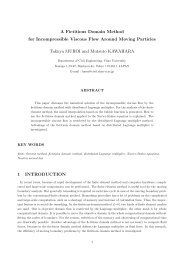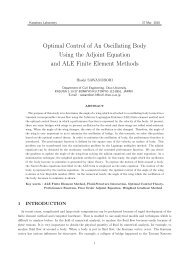Parameter Identification of Manning Roughness Coefficient Using ...
Parameter Identification of Manning Roughness Coefficient Using ...
Parameter Identification of Manning Roughness Coefficient Using ...
Create successful ePaper yourself
Turn your PDF publications into a flip-book with our unique Google optimized e-Paper software.
˙ ξ + ξ ,i u i + ξu i,i = 0, (2)<br />
˙η + Λu i,i =0, (3)<br />
where u i , g, ξ and η are the water velocity,the gravitational<br />
acceleration,the water elevation and the<br />
bed elevation,respectively. The coefficient <strong>of</strong> kinematic<br />
eddy viscosity ν,f and Λ are expressed as<br />
follows;<br />
ν = k l<br />
6 u ∗ ξ, f = u ∗<br />
ξ , Λ= q s<br />
(1 − e ) √ ,<br />
u k u k<br />
where k l , u ∗ , e and q s are the Kalman constant,the<br />
friction velocity,the porosity <strong>of</strong> sand and the bedload<br />
quantity,respectively. The friction velocity u ∗<br />
is expressed as follows;<br />
√<br />
u ∗ = gn2 uk u k<br />
,<br />
ξ 1/3<br />
where n is the <strong>Manning</strong> roughness coefficient.<br />
The bed-load quantity q s is determined by a relation<br />
between the tractive force and the limit tractive<br />
force. The tractive force τ 0 is caused by the water<br />
flow. The limit tractive force τ c is expressed as follows;<br />
τ c = σg( ρ s − ρ w ) d m ,<br />
where σ, ρ s , ρ w and d m are the shields parameter,the<br />
density <strong>of</strong> water,the density <strong>of</strong> sand and<br />
the sandy average particle size,respectively. The<br />
Meyer-Peter Müller equation is used as an equation<br />
so as to express the bed-load quantity.<br />
If τ 0 >τ c ,<br />
√<br />
1 1<br />
q s =8<br />
ρ w g ( ρ s − ρ w ) ( τ 0 − τ c ) 3 2 .<br />
If τ 0 ≤ τ c , q s =0.<br />
3. Spatial Discretization<br />
3.1 Bubble Function Element<br />
As for the spatial discretization,the interpolation <strong>of</strong><br />
bubble function element for the velocity,the water<br />
elevation and the bed elevation fields as shows in<br />
Fig.2 is used. The bubble function element is expressed<br />
as follows;<br />
u i = Φ 1 u i1 + Φ 2 u i2 + Φ 3 u i3 + Φ 4 ũ i4 ,<br />
ũ i4 = u i4 − 1 3 ( u i1 + u i2 + u i3 ),<br />
ξ = Φ 1 ξ 1 + Φ 2 ξ 2 + Φ 3 ξ 3 + Φ 4 ˜ξ4 ,<br />
˜ξ 4 = ξ 4 − 1 3 ( ξ 1 + ξ 2 + ξ 3 ),<br />
where φ e is the bubble function <strong>of</strong> C 0 continuous<br />
and Φ α ( α = 1 ∼ 4 ) is the bubble function element.<br />
3<br />
s<br />
1<br />
Fig.2<br />
4<br />
2<br />
Bubble Function<br />
Element<br />
r<br />
1.0<br />
s<br />
ω 2<br />
ω 1<br />
ω 3<br />
r<br />
0.0<br />
1.0<br />
Fig.3 Subdivision <strong>of</strong><br />
Element<br />
The bubble function is defined by using the<br />
isoparametric coordinates ( r, s ) as shows in Fig.3.<br />
Three triangles ( ω 1 ∼ ω 3 ) is divided at the barycenter<br />
point. The bubble function <strong>of</strong>C 0 continuous can<br />
be considered on each sub-triangle as the following<br />
equation;<br />
⎧<br />
⎨ 3(1− r − s ) in ω 1<br />
φ e = 3 r in ω<br />
⎩<br />
2<br />
3 s in ω 3 .<br />
3.2 Improved Bubble Element<br />
The bubble function is capable <strong>of</strong> eliminating the<br />
barycenter point by using the static condensation.<br />
The discretized form derived from the bubble<br />
function element is equivalent to those from the<br />
SUPG[2]. Therefore,the stabilized parameter which<br />
is derived from the bubble function element is expressed<br />
as follows;<br />
〈 momentum equation for shallow water flow 〉<br />
τ eBui =<br />
〈φ e , 1〉 2 Ω e<br />
A −1<br />
e<br />
1<br />
∆t ‖ φ e ‖ 2 Ω e<br />
+ 1 2 [(ν +˜ν)2 ‖ φ e,j ‖ 2 Ω e<br />
−f ‖ φ e ‖ 2 Ω e<br />
] ,<br />
〈 continuity equations<br />
for shallow water flow and sand 〉<br />
〈φ e , 1〉 2 Ω<br />
τ eBη =<br />
e<br />
A −1<br />
e<br />
1<br />
∆t ‖ φ e ‖ 2 Ω e<br />
+ 1 2 [˜ν ‖ φ e,j ‖ 2 Ω e<br />
] ,<br />
where ˜ν is the stabilized control parameter. From<br />
the criteria for the stabilized parameter in the<br />
SUPG,an optimal parameter can be given as follows;<br />
〈 momentum equation for shallow water flow 〉<br />
η = Φ 1 η 1 + Φ 2 η 2 + Φ 3 η 3 + Φ 4 ˜η 4 ,<br />
˜η 4 = η 4 − 1 3 ( η 1 + η 2 + η 3 ),<br />
Φ 1 = 1 − r − s, Φ 2 = r, Φ 3 = s, Φ 4 = φ e ,<br />
19<br />
τ eBui =<br />
( 1<br />
2 τ −1<br />
es + α ∆t<br />
) −1<br />
,<br />
[ ( ) 2<br />
τes −1 2 | U i |<br />
=<br />
+<br />
h e<br />
( 4ν<br />
h 2 e<br />
) 2 ] 1<br />
2<br />
,










